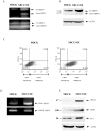The effect of a DNA repair gene on cellular invasiveness: XRCC3 over-expression in breast cancer cells
- PMID: 21283680
- PMCID: PMC3025979
- DOI: 10.1371/journal.pone.0016394
The effect of a DNA repair gene on cellular invasiveness: XRCC3 over-expression in breast cancer cells
Abstract
Over-expression of DNA repair genes has been associated with resistance to radiation and DNA-damage induced by chemotherapeutic agents such as cisplatin. More recently, based on the analysis of genome expression profiling, it was proposed that over-expression of DNA repair genes enhances the invasive behaviour of tumour cells. In this study we present experimental evidence utilizing functional assays to test this hypothesis. We assessed the effect of the DNA repair proteins known as X-ray complementing protein 3 (XRCC3) and RAD51, to the invasive behavior of the MCF-7 luminal epithelial-like and BT20 basal-like triple negative human breast cancer cell lines. We report that stable or transient over-expression of XRCC3 but not RAD51 increased invasiveness in both cell lines in vitro. Moreover, XRCC3 over-expressing MCF-7 cells also showed a higher tumorigenesis in vivo and this phenotype was associated with increased activity of the metalloproteinase MMP-9 and the expression of known modulators of cell-cell adhesion and metastasis such as CD44, ID-1, DDR1 and TFF1. Our results suggest that in addition to its' role in facilitating repair of DNA damage, XRCC3 affects invasiveness of breast cancer cell lines and the expression of genes associated with cell adhesion and invasion.
Conflict of interest statement
Figures



References
-
- Jemal A, Siegel R, Ward E, Murray T, Xu J, et al. Cancer statistics, 2007. CA Cancer J Clin. 2007;57:43–66. - PubMed
-
- Toronto: Canadian Cancer Society's Steering Committee; Canadian Cancer Statistics 2010.
-
- Aloyz R, Xu ZY, Bello V, Bergeron J, Han FY, et al. Regulation of cisplatin resistance and homologous recombinational repair by the TFIIH subunit XPD. Cancer Res. 2002;62:5457–5462. - PubMed
Publication types
MeSH terms
Substances
LinkOut - more resources
Full Text Sources
Medical
Research Materials
Miscellaneous

